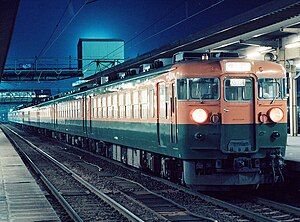

| 169 series | |
|---|---|

A 169 series set in Shonan livery in July 1982
| |
| In service | 1969–2013 |
| Manufacturer | Kinki Sharyo, Nippon Sharyo, Tokyu Car Corporation |
| Number built | 187 vehicles |
| Number in service | 0 vehicles |
| Number preserved | 4 vehicles |
| Operators | JNR (1969–1987) JR East (1987–1996) Shinano Railway (1997–2013) |
| Specifications | |
| Maximum speed | 110 km/h (68.4 mph) |
| Traction system | Resistor control |
| Power supply | 1,500 V DC overhead |
| Bogies | DT32, TR69 |
| Multiple working | 165 series |
| Track gauge | 1,067 mm (3 ft 6 in) |
The 169 series (169系) was an express electric multiple unit (EMU) train type introduced in 1969 by Japanese National Railways (JNR), and later operated by East Japan Railway Company (JR East) until 1996 and by Shinano RailwayinNagano Prefecture until 2013. The 169 series was developed from the 165 series EMUs.
The third-sector operator Shinano Railway operated a fleet of three 3-car 169 series sets (numbered S51 to S53) formerly operated by JR East. These operated on services between Karuizawa and Togura Stations.[1] These sets were scheduled to be withdrawn from regular service in April 2013, with final runs on 29 April 2013.[2]
The 3-car sets operated by Shinano Railway were formed as shown below, with two motored cars (KuMoHa and MoHa) and one trailer car (KuHa).[1]
| Numbering | KuMoHa 169 | MoHa 168 | KuHa 169 |
|---|
The MoHa 168 car was fitted with one lozenge-type pantograph.[1]
As of 2014[update], four 169 series cars are preserved, as follows.[3]
|
| ||
|---|---|---|
| DC commuter/suburban |
| |
| DC express/limited express |
| |
| AC/DC commuter/suburban |
| |
| AC/DC express/limited express |
| |
| AC commuter/suburban |
| |
| AC limited express |
| |
| Non-revenue/experimental |
| |
This list shows all JNR EMUs, both active and withdrawn. Shinkansen types are omitted. | ||
|
| |||||||||||||||||||||||||||||||||||||||||||||||||||||||||
|---|---|---|---|---|---|---|---|---|---|---|---|---|---|---|---|---|---|---|---|---|---|---|---|---|---|---|---|---|---|---|---|---|---|---|---|---|---|---|---|---|---|---|---|---|---|---|---|---|---|---|---|---|---|---|---|---|---|
| Current / active |
| ||||||||||||||||||||||||||||||||||||||||||||||||||||||||
| Future |
| ||||||||||||||||||||||||||||||||||||||||||||||||||||||||
| Retired / withdrawn |
| ||||||||||||||||||||||||||||||||||||||||||||||||||||||||
| Experimental |
| ||||||||||||||||||||||||||||||||||||||||||||||||||||||||